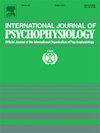Interplay of phonological and orthographic electrophysiological processing during reading in Spanish
IF 2.5
3区 心理学
Q3 NEUROSCIENCES
引用次数: 0
Abstract
Spanish is a transparent language with a high degree of consistency of print-speech correspondences, thus facilitating written word recognition. However, most of the orthographic errors in Spanish do not alter the phonological representation of the words, thus leading to potential conflicts with their visual portrayal in memory. This study explored whether spelling errors affect semantic processing by analyzing the behavioral and electrophysiological effects during sentence reading in 35 native Spanish-speaking young adults. The experimental paradigm consisted of 170 six-word sentences; the closing word of each sentence could be a) congruent, b) congruent with a homophone error, c) congruent with a typo error, d) incongruent, and e) incongruent with a homophone error. Participants performed a semantic decision task with simultaneous EEG recording, in which they were explicitly instructed to ignore spelling errors and to attend only to the semantic congruency of the sentence when responding. Behaviorally, accuracy only decreased with typo errors, while mean reaction times were significantly increased by both types of errors. Electrophysiological results showed a classic N400, in which orthographic errors had no effect, reinforcing the notion that this component is mainly determined by semantic incongruency. On the other hand, orthographic expectancy violations were reflected by a late slow positivity rather than a larger N400 amplitude suggesting that spelling information is not fully processed when deeper, more complex linguistic aspects of written language are being analyzed. This P600-like component is interpreted as signaling the re-evaluation of an error, regardless of whether it is semantic or orthographic in nature.
西班牙语阅读中语音和正字法电生理加工的相互作用。
西班牙语是一种透明的语言,具有高度的印刷-语音对应一致性,因此便于书面单词识别。然而,西班牙语中的大多数正字法错误不会改变单词的语音表示,从而导致与记忆中视觉描述的潜在冲突。本研究通过分析35名母语为西班牙语的年轻人在句子阅读过程中的行为和电生理效应,探讨拼写错误是否影响语义加工。实验范式由170个6字句子组成;每个句子的结尾词可以是a)一致,b)一致但有同音字错误,c)一致但有打字错误,d)不一致,e)不一致但有同音字错误。参与者通过同时记录脑电图来完成语义决策任务,在这个任务中,他们被明确指示忽略拼写错误,在回答时只注意句子的语义一致性。从行为上看,拼写错误只会降低准确性,而两种类型的错误都显著增加了平均反应时间。电生理结果显示典型的N400,其中正字法错误没有影响,加强了这一成分主要由语义不一致决定的概念。另一方面,正字法期望的违反反映在一个较晚的缓慢的正性上,而不是一个较大的N400振幅,这表明在分析书面语言的更深、更复杂的语言方面时,拼写信息没有被完全处理。这个类似p600的组件被解释为对错误进行重新评估的信号,而不管它本质上是语义的还是正字法的。
本文章由计算机程序翻译,如有差异,请以英文原文为准。
求助全文
约1分钟内获得全文
求助全文
来源期刊
CiteScore
5.40
自引率
10.00%
发文量
177
审稿时长
3-8 weeks
期刊介绍:
The International Journal of Psychophysiology is the official journal of the International Organization of Psychophysiology, and provides a respected forum for the publication of high quality original contributions on all aspects of psychophysiology. The journal is interdisciplinary and aims to integrate the neurosciences and behavioral sciences. Empirical, theoretical, and review articles are encouraged in the following areas:
• Cerebral psychophysiology: including functional brain mapping and neuroimaging with Event-Related Potentials (ERPs), Positron Emission Tomography (PET), Functional Magnetic Resonance Imaging (fMRI) and Electroencephalographic studies.
• Autonomic functions: including bilateral electrodermal activity, pupillometry and blood volume changes.
• Cardiovascular Psychophysiology:including studies of blood pressure, cardiac functioning and respiration.
• Somatic psychophysiology: including muscle activity, eye movements and eye blinks.

 求助内容:
求助内容: 应助结果提醒方式:
应助结果提醒方式:


